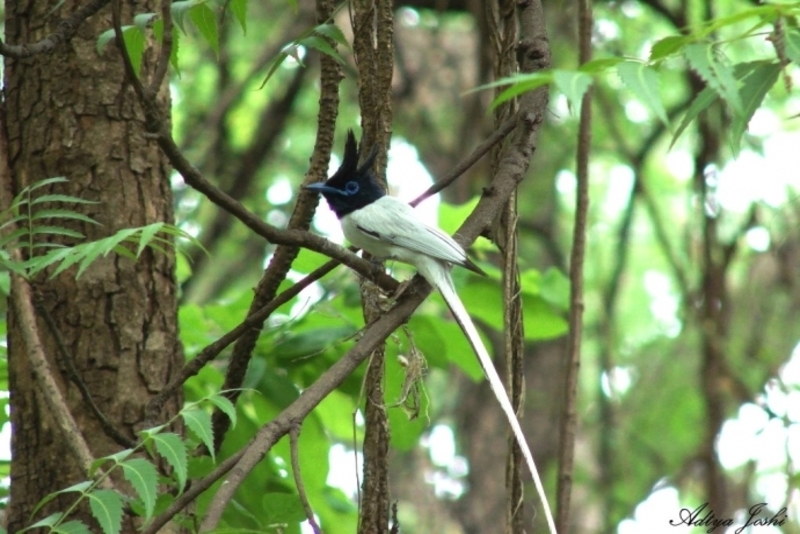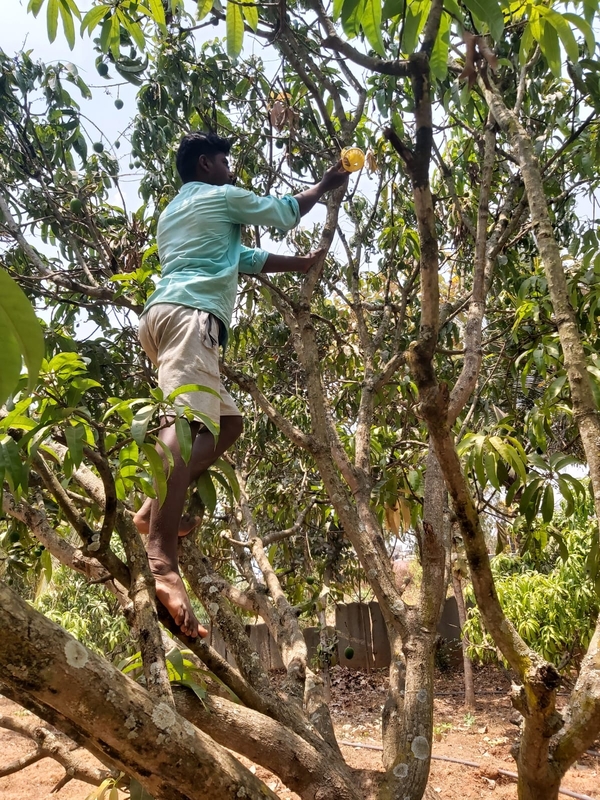Indian Paradise Flycatcher, Bangalore, India

I had seen the bird in my village in Goa -- Pilerne-- where it would come every morning and afternoon to feast on insects off the teak trees outside our window. The first time I saw it was a stunning moment for me and I sat entranced on the bench in the verandah of the house enjoying the beauty of the bird as it flitted from tree to tree, with it’s long tail feathers trailing behind in a spectacular ribbon dance. The bird I saw in Goa was brick coloured and quite stunning but not quite as beautiful as this black and white specimen.
Ofcourse I had to read up on my faithful google about the bird to learn it is not endangered and quite common in the wild. The Indian paradise flycatcher (Terpsiphone paradisi ) is a fist-sized passerine bird native to Asia, where it is widely distributed. As the global population is considered stable, it has been listed as Least Concern on the IUCN Red List since 2004. It is native to the Indian subcontinent, Central Asia and Myanmar.
Then one morning in the winter of 2019, early January, I heard the harsh screechy call of the bird and went out into my balcony to check. I was quite sure I would not see the Indian Paradise Flycatcher surely in the heart of the city of Bangalore? Standing there silently, I scanned the branches around of the tamarind tree in the neighbouring compound.
We are so lucky to have massive tamarind trees, at least 40 years old, growing on the periphery of our and the back property. The branches are huge and extending happily into our compound. And there, my eyes could not be deceiving me. There was a beautiful black and white Asian Paradise Flycatcher flitting between the branches with its beautiful, white ribbon like tail, pirouetting behind it.
Everyday for about a month the bird made its appearance. Signalling its presence with its screechy call. Then as silently as it came it disappeared. Happily for me it has made its appearance for me late Jan early Feb 2020, as I was away in the West for a while.
A very graceful looking flycatcher, only the adult male sports a long ribbonlike tail. The males occur in two colours, cinnamon and white said Google, just like I had seen. Both colours sport a glossy black head with blue ring around the eye, but the white morph is entirely white below while the cinnamon morph has cinnamon upperparts and tail, and dirty white underparts.
The females are cinnamon above with a grayish throat, a shorter tail, and they lack the male’s blue eye-ring. They make short aerial sallies after insects, usually returning to the same perch. Occasionally descends to ground to pull apart insects. Chiefly found in wooded habitats. Their call is a harsh “shreew.”
According to Google, they are best seen during the breeding summer and monsoon months as they become more vocal and active during this time. That is probably on the city outskirts, but for me, he seems to like visiting in the winter!
Main photo Courtesy: Ashish Tirkey
Ofcourse I had to read up on my faithful google about the bird to learn it is not endangered and quite common in the wild. The Indian paradise flycatcher (Terpsiphone paradisi ) is a fist-sized passerine bird native to Asia, where it is widely distributed. As the global population is considered stable, it has been listed as Least Concern on the IUCN Red List since 2004. It is native to the Indian subcontinent, Central Asia and Myanmar.
Then one morning in the winter of 2019, early January, I heard the harsh screechy call of the bird and went out into my balcony to check. I was quite sure I would not see the Indian Paradise Flycatcher surely in the heart of the city of Bangalore? Standing there silently, I scanned the branches around of the tamarind tree in the neighbouring compound.
We are so lucky to have massive tamarind trees, at least 40 years old, growing on the periphery of our and the back property. The branches are huge and extending happily into our compound. And there, my eyes could not be deceiving me. There was a beautiful black and white Asian Paradise Flycatcher flitting between the branches with its beautiful, white ribbon like tail, pirouetting behind it.
Everyday for about a month the bird made its appearance. Signalling its presence with its screechy call. Then as silently as it came it disappeared. Happily for me it has made its appearance for me late Jan early Feb 2020, as I was away in the West for a while.
A very graceful looking flycatcher, only the adult male sports a long ribbonlike tail. The males occur in two colours, cinnamon and white said Google, just like I had seen. Both colours sport a glossy black head with blue ring around the eye, but the white morph is entirely white below while the cinnamon morph has cinnamon upperparts and tail, and dirty white underparts.
The females are cinnamon above with a grayish throat, a shorter tail, and they lack the male’s blue eye-ring. They make short aerial sallies after insects, usually returning to the same perch. Occasionally descends to ground to pull apart insects. Chiefly found in wooded habitats. Their call is a harsh “shreew.”
According to Google, they are best seen during the breeding summer and monsoon months as they become more vocal and active during this time. That is probably on the city outskirts, but for me, he seems to like visiting in the winter!
Main photo Courtesy: Ashish Tirkey

Related Articles
Editor's Picks Articles
Top Ten Articles
Previous Features
Site Map
Content copyright © 2023 by Marianne de Nazareth. All rights reserved.
This content was written by Marianne de Nazareth. If you wish to use this content in any manner, you need written permission. Contact Marianne de Nazareth for details.





 -resizeimage.jpg.jpg)

